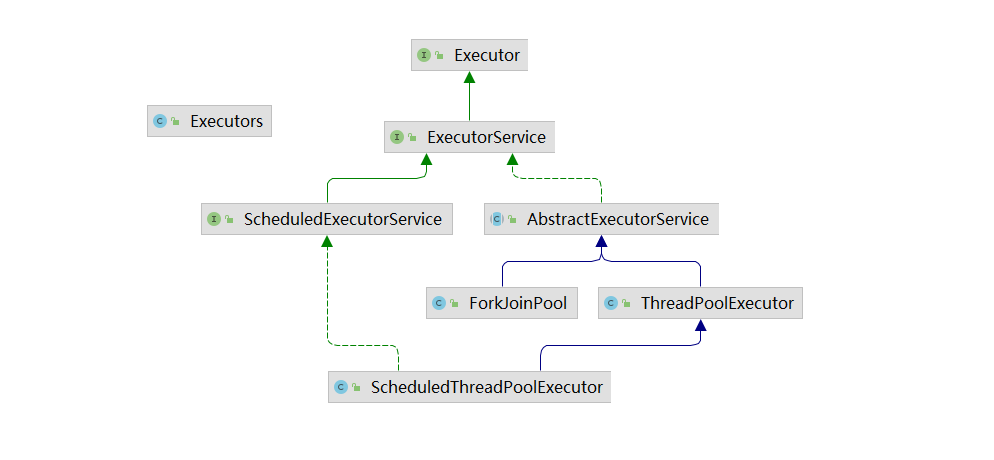线程池
1、简介
关于池化技术,之前或多或少都了解过一些,池化技术的出现是为了解决两方面的问题:
- 程序向操作系统申请资源所带来的性能消耗;
- 程序对系统资源的管理。
比如说 JDBC 连接池、Java 对象池、内存池、线程池,使用它们可以带来如下好处:
- 降低资源的消耗;
- 提高程序响应的速度;
- 方便管理;
比如说线程池:可以复用线程、控制最大并发数、管理线程资源。
线程池重要的知识点:三大方法、七大参数、四种拒绝策略
2、分析
从 JDK 1.5 开始 JDK 的开发团队为 Java 引入了和线程池相关的一些接口和类:

Executor定义了线程池可以执行Runnable类型的任务;ExecutorService定义了线程池的一些管理操作;AbstractExecutorService提供了ExecutorService的默认实现;
Executors 工厂工具类则提供了各种方法用于构建不同类型的 Executor,其本质就是初始参数不同的 ThreadPoolExecutor,一般建议开发者直接创建 ThreadPoolExecutor 对象,这样可以更好的理解各种线程池的运行规则。
3、Executors
Executors 中有三个方法最常用:
newSingleThreadExecutor:创建单线程池, 即只有一个线程的线程池, 可以为其传递一个ThreadFactory类型的工厂实例用于创建线程;newFixedThreadPool:固定大小的线程池, 即固定线程数的线程池, 注意必须指定线程的总数量, 同时也有一个可选的ThreadFactory参数;newCachedThreadPool:可伸缩的线程池, 本质上是将最大线程数设置为Integer.MAX_VALUE, 也有一个可选的ThreadFactory参数。
测试代码如下:
public class EDemo01 {
public static void main(String[] args) {
ExecutorService singlePool = Executors.newSingleThreadExecutor();
ExecutorService fixPool = Executors.newFixedThreadPool(5);
ExecutorService cachedPool = Executors.newCachedThreadPool();
run(singlePool); // 一条线程运行 10 次
// run(fixPool); // 最多只有 5 条线程
// run(cachedPool); // 线程数量不限 <= Integer.MAX_VALUE
}
public static void run(ExecutorService pool) {
try {
for (int i = 0; i < 10; i++) {
pool.execute(() -> {
System.out.println(Thread.currentThread().getName() + " finish task");
});
}
} finally {
pool.shutdown();
}
}
}4、ThreadPoolExecutor
(1)Executors 分析
上面介绍的 Executors 的三个方法本质上其实是创建了不同的 ThreadPoolExecutor 对象:
源码如下:
public static ExecutorService newSingleThreadExecutor() {
return new FinalizableDelegatedExecutorService
(new ThreadPoolExecutor(1, 1,
0L, TimeUnit.MILLISECONDS,
new LinkedBlockingQueue<Runnable>()));
}
public static ExecutorService newFixedThreadPool(int nThreads) {
return new ThreadPoolExecutor(nThreads, nThreads,
0L, TimeUnit.MILLISECONDS,
new LinkedBlockingQueue<Runnable>());
}
public static ExecutorService newCachedThreadPool() {
return new ThreadPoolExecutor(0, Integer.MAX_VALUE,
60L, TimeUnit.SECONDS,
new SynchronousQueue<Runnable>());
}可以看到它们的本质其实是创建 ThreadPoolExecutor 对象。
(2)构造参数分析
重点看 ThreadPoolExecutor 类。
public class ThreadPoolExecutor extends AbstractExecutorService {}
public abstract class AbstractExecutorService implements ExecutorService {}
public interface ExecutorService extends Executor {}结合前面的继承图,我们知道,ExecutorService 定义了线程池使用池中的线程处理任务的能力以及一些管理方法,AbstractExecutorService 则为其提供了默认实现,而 ThreadPoolExecutor 在前者的基础上维护了一些统计信息。
看一下 ThreadPoolExecutor 的比较全面的构造函数:
public ThreadPoolExecutor(int corePoolSize,
int maximumPoolSize,
long keepAliveTime,
TimeUnit unit,
BlockingQueue<Runnable> workQueue,
ThreadFactory threadFactory,
RejectedExecutionHandler handler) {
if (corePoolSize < 0 ||
maximumPoolSize <= 0 ||
maximumPoolSize < corePoolSize ||
keepAliveTime < 0)
throw new IllegalArgumentException();
if (workQueue == null || threadFactory == null || handler == null)
throw new NullPointerException();
this.acc = System.getSecurityManager() == null ?
null :
AccessController.getContext();
this.corePoolSize = corePoolSize;
this.maximumPoolSize = maximumPoolSize;
this.workQueue = workQueue;
this.keepAliveTime = unit.toNanos(keepAliveTime);
this.threadFactory = threadFactory;
this.handler = handler;
}里面主要有这几个参数:
corePoolSize:核心线程池大小(最小数量);maximumPoolSize:线程池拥有线程的最大数量;keepAliveTime:空闲线程的超时时间,以纳秒为单位,当线程池中空闲线程的数量超过corePoolSize或者allowCoreThreadTimeOut设置为 true,线程就会使用这个参数,一旦超过了这个时间,相关的线程就会被释放,否则的话线程将会一直处于等待状态,直到新任务到来;- 补充一个没有在构造函数参数列表的属性:
allowCoreThreadTimeOut:该属性为布尔值,默认为 false,表示核心线程不受超时时间影响,意味着线程池最低存活的线程数量就是核心线程数量,如果设置为 true,则线程池所有线程都受到超时时间影响; unit:超时单位,用于将keepAliveTime参数转换为 nano;workQueue:阻塞队列,当请求执行的任务数量超过了线程池的最大线程数量,此时就需要阻塞队列来接收这些暂时无法处理的任务;threadFactory:线程工厂,用于创建线程;handler:拒绝策略;
了解了这些参数,我们在看之前使用 Executors 构建的三种不同的线程池,便会发现一些问题,虽然使用 Executors 非常方便,但是它构建的线程池其实是不安全的,这是因为:
(1)FixedThreadPool 和 SingleThreadPool 使用的阻塞队列是 LinkedBlockingQueue 且没有指定队列的最大长度,此时使用的是默认的最大长度 Integer.MAX_VALUE,可能会堆积大量的请求,从而导致 OOM;
(2)CachedThreadPool 虽然使用的是 SynchronousQueue 同步队列,但是其线程池的最大线程数量是 Integer.MAX_VALUE,可能会创建大量的线程,造成 OOM。
综上:如果要使用线程池,推荐自定义 ThreadPoolExecutor,既能明确线程池的运行规则,也可以避免资源耗尽的风险。
例如这样:
public class EDemo02 {
public static void main(String[] args) {
ExecutorService executor = new ThreadPoolExecutor(
2, // 核心线程数量
5, // 最大线程数量
3, // 存活时间
TimeUnit.SECONDS, // 存活时间的单位
new LinkedBlockingQueue<>(3), // 阻塞队列, 设置了最大长度
Executors.defaultThreadFactory(), // 线程构建工厂
new ThreadPoolExecutor.AbortPolicy() // 拒绝策略: 此处采用抛出异常处理
);
try {
for (int i = 0; i < 100; i++) {
executor.execute(() -> {
System.out.println(Thread.currentThread().getName() + " process work ...");
});
}
} finally {
executor.shutdown();
}
}
}运行结果:

可以看到当处理的任务数量超过(线程池最大线程数量 + 阻塞队列最大长度)之后,线程池直接拒绝了新的任务(同时抛出了异常)。
(3)拒绝策略
上面的例子中使用的拒绝策略是 AbortPolicy,线程池无法处理新的任务时会抛弃该任务,同时抛出异常。
ThreadPoolExecutor 中预定义了四种拒绝策略:
1、CallerRunsPolicy:谁将任务发给线程池处理,这个任务就回到哪里去,在上面的例子中如果采用了该策略,无法处理的任务就交给 main 线程处理;
public static class CallerRunsPolicy implements RejectedExecutionHandler {
/**
* Creates a {@code CallerRunsPolicy}.
*/
public CallerRunsPolicy() { }
/**
* Executes task r in the caller's thread, unless the executor
* has been shut down, in which case the task is discarded.
*
* @param r the runnable task requested to be executed
* @param e the executor attempting to execute this task
*/
public void rejectedExecution(Runnable r, ThreadPoolExecutor e) {
if (!e.isShutdown()) {
r.run();
}
}
}2、AbortPolicy:将无法处理的任务丢弃同时抛出异常;
public static class AbortPolicy implements RejectedExecutionHandler {
/**
* Creates an {@code AbortPolicy}.
*/
public AbortPolicy() { }
/**
* Always throws RejectedExecutionException.
*
* @param r the runnable task requested to be executed
* @param e the executor attempting to execute this task
* @throws RejectedExecutionException always
*/
public void rejectedExecution(Runnable r, ThreadPoolExecutor e) {
throw new RejectedExecutionException("Task " + r.toString() +
" rejected from " +
e.toString());
}
}3、DiscardPolicy:将无法处理的任务悄悄的丢弃,不做任何处理;
public static class DiscardPolicy implements RejectedExecutionHandler {
/**
* Creates a {@code DiscardPolicy}.
*/
public DiscardPolicy() { }
/**
* Does nothing, which has the effect of discarding task r.
*
* @param r the runnable task requested to be executed
* @param e the executor attempting to execute this task
*/
public void rejectedExecution(Runnable r, ThreadPoolExecutor e) {
}
}4、DiscardOldestPolicy:当新任务请求到来时,先判断线程池是否已经关闭,如果未关闭,就将阻塞队列中等待时间最长的任务丢弃(也就是队列的头),然后尝试调用线程池执行新的任务,如果此时线程池已经关闭,则直接丢弃新任务。
public static class DiscardOldestPolicy implements RejectedExecutionHandler {
/**
* Creates a {@code DiscardOldestPolicy} for the given executor.
*/
public DiscardOldestPolicy() { }
/**
* Obtains and ignores the next task that the executor
* would otherwise execute, if one is immediately available,
* and then retries execution of task r, unless the executor
* is shut down, in which case task r is instead discarded.
*
* @param r the runnable task requested to be executed
* @param e the executor attempting to execute this task
*/
public void rejectedExecution(Runnable r, ThreadPoolExecutor e) {
if (!e.isShutdown()) {
e.getQueue().poll();
e.execute(r);
}
}
}(4)自定义拒绝策略
上面四种拒绝策略是 ThreadPoolExecutor 实现定义好的,如果要自定义拒绝策略,可以通过实现 RejectedExecutionHandler 来完成自己想要的功能。
public interface RejectedExecutionHandler {
/**
* Method that may be invoked by a {@link ThreadPoolExecutor} when
* {@link ThreadPoolExecutor#execute execute} cannot accept a
* task. This may occur when no more threads or queue slots are
* available because their bounds would be exceeded, or upon
* shutdown of the Executor.
*
* <p>In the absence of other alternatives, the method may throw
* an unchecked {@link RejectedExecutionException}, which will be
* propagated to the caller of {@code execute}.
*
* @param r the runnable task requested to be executed
* @param executor the executor attempting to execute this task
* @throws RejectedExecutionException if there is no remedy
*/
void rejectedExecution(Runnable r, ThreadPoolExecutor executor);
}5、CPU 密集型和 IO 密集型
学习了线程池相关的知识后,我们知道应该通过自定义 ThreadPoolExecutor 去自定义线程池,而定制的依据和硬件及程序有关。
可以分为两类:
(1)CPU 密集型
机器有几个处理器,就将线程池的最大线程设置为该数量,这样可以保证 CPU 的效率最高。
可以通过 Runtime.getRuntime().availableProcessors() 来获取当前系统的 CPU 核数,将该值设置为线程池的最大线程数。
(2)IO 密集型
当我们的应用程序中存在较多的大型任务,且 IO 非常占用资源时,我们可以将这些大型任务的数量设置为线程池的核心线程数,核心线程数 >= 耗费大量资源任务的数量。



